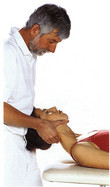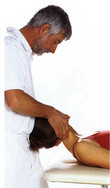Manual stretching resolves acute tension or chronic muscle hardening. It interrupts existing problems, relieves pain and improves metabolism in the area around the hardening. The optimal treatment is a combination of manual stretching by a therapist and stretching exercises.
|
Stretching of the segmental muscles of the neck
(Interspinalis cervicalis):
|
|
Stretching of the lower fixators of the shoulder girdle
(Trapezius inferior, rhomboids):
|
a)
With the patient in a supine position the therapist grasps the neck and head with both hands and pulls them towards his/her own body. With the fingertips of the second and third fingers the neck muscles are drawn laterally away from the acanthi and pre-tensioned in a u-shaped manner. To stretch, the head is raised slightly under traction.
|

|
|
a)
The therapist's hands grasp the scapula and apply pressure so that the tip of the shoulder blade is pushed over his/her fingers. To stretch, the right shoulder blade is lifted away from the supporting surface and turned to the right.
|
b)
The stretching of the right side of the neck is intensified by simultaneous rotation of the head to the left.
|
 |
|
b)
By applying pressure from above the therapist moves the shoulder blade over the second hand. To stretch, the right shoulder blade is turned to the left.
|



